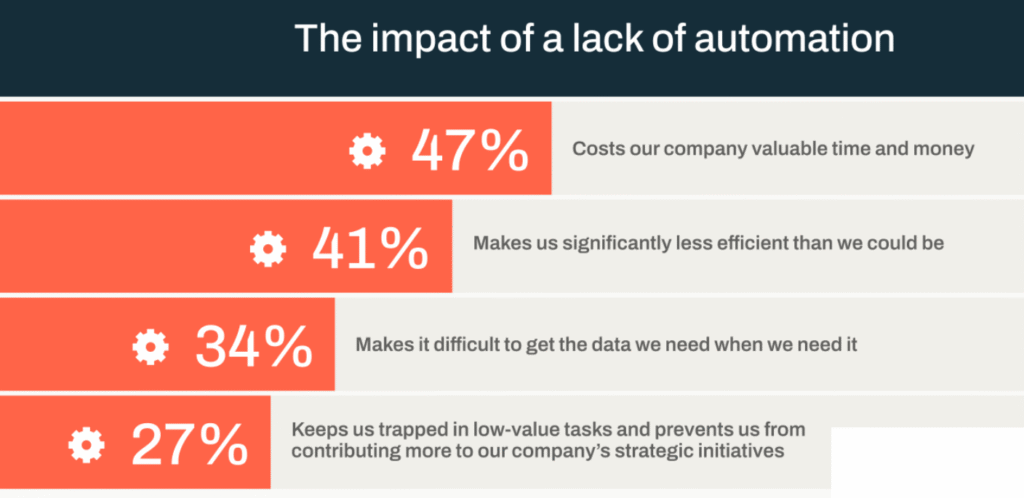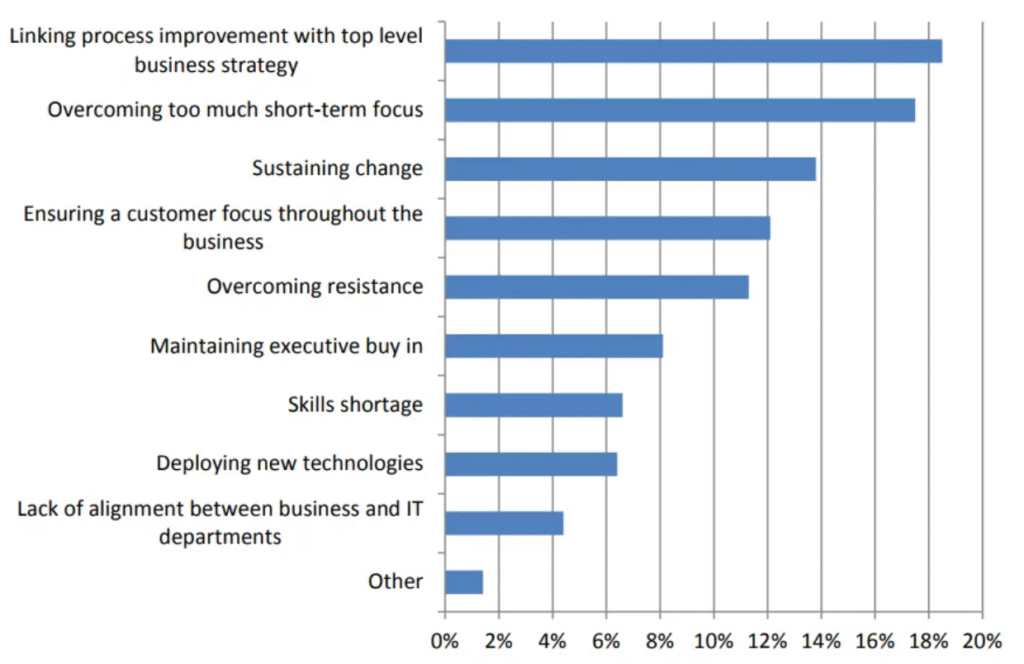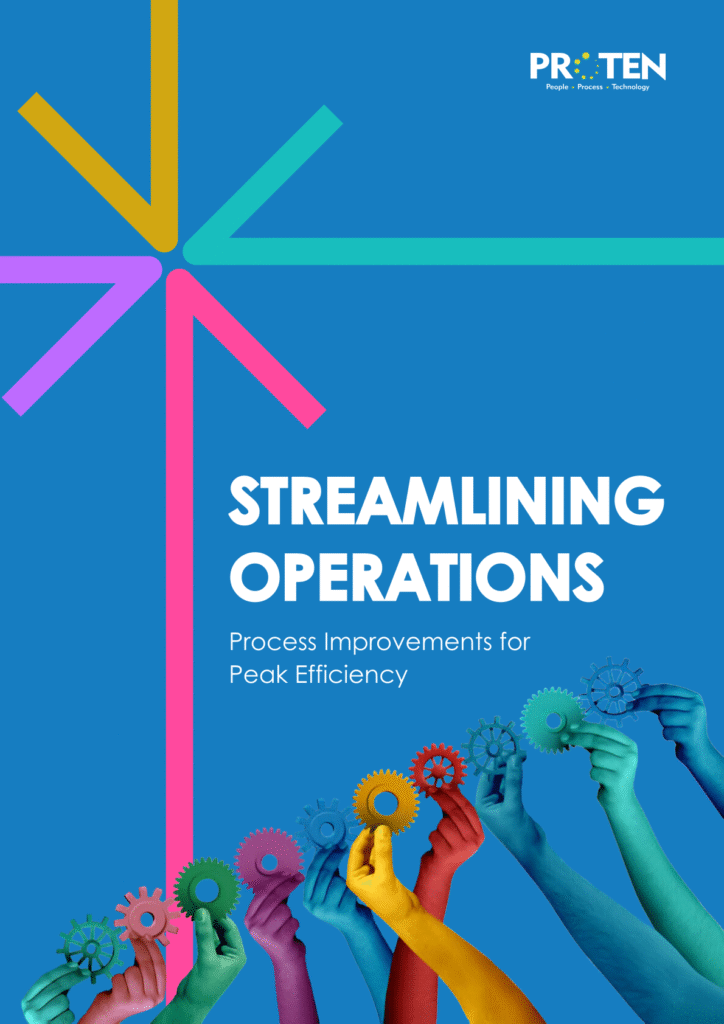In Nigeria’s dynamic business environment, corporations face increasing pressure to optimise operations to remain competitive, reduce costs, and enhance productivity. HR managers, in particular, play a pivotal role in driving efficiency by optimising talent acquisition, employee management, and administrative processes. Process improvement in organisations focuses on identifying and resolving inefficiencies in current workflows to boost effectiveness, streamline operations, and improve customer satisfaction.
According to research by IDC, companies lose 20-30% every year to inefficiencies. This is just one of the multifaceted consequences of outdated processes. The next few pages provides a comprehensive guide to process improvements that enable corporations to achieve peak efficiency, with a focus on actionable strategies for HR managers.
2. The Importance of Streamlining Operations

Source: Intercom (AI in Customer Service)
Streamlining operations involves analysing and optimising processes to eliminate waste, reduce redundancies, and enhance productivity. For corporations, the benefits include:
- Cost Reduction: Streamlined processes minimise resource wastage, lowering operational costs. For example, according to McKinsey, automating payroll can reduce manual errors and processing time by up to 66%.
- Improved Productivity: Simplified workflows allow employees to focus on high-value tasks, boosting output. Time cost per unit output also reduces leading to more productivity.
- Enhanced Employee Satisfaction: Employees who work efficiently are likely to be more satisfied with their jobs. Efficient HR processes, such as seamless onboarding, improve morale and retention.
- Competitive Advantage: When processes are streamlined, customers are more likely to have a positive experience. The overall system enables faster response times to market demands, critical in Nigeria’s competitive landscape.
- Compliance and Risk Management: In certain instances, automated systems and processes ensure adherence to labour laws, reducing the risk of penalties resulting from human error.
3. Key Strategies for Process Improvement
3.1 Process Mapping and Analysis
Process mapping involves documenting workflows to identify inefficiencies, bottlenecks, and redundancies. By creating visual diagrams (e.g., flowcharts or value stream maps), HR managers can pinpoint areas for improvement. For instance, mapping the recruitment process may reveal delays in candidate screening due to manual reviews.
Steps for Process Mapping:
- List all steps in a process, including responsible parties and resources.
- Identify redundancies or non-value-adding steps.
- Prioritise processes for improvement based on impact and feasibility.
3.2 Automation and Technology Integration

Source: Airbase
Automation transforms operations by reducing manual tasks and improving accuracy. Technologies like Enterprise Resource Planning (ERP) systems, Customer Relationship Management (CRM) software, and supply chain management tools are critical for businesses. Some useful technological tools for process improvement include:
ERP Systems: Platforms that integrate finance, inventory, and HR processes, have been found to be very helpful here. According to Flexsin, SMEs have cut their operational costs by 30% using operational tools like Odoo.
CRM Software: Data from Salesforce in 2024 have shown that CRM software improves response times by up to 40%. These tools help organisations streamline customer interactions, automate tasks efficiently, and optimise customer data and sales processes.
IoT and Analytics: Internet of Things (IoT) devices optimise logistics by tracking shipments in real-time, critical in challenging transport networks.
Cloud-Based Solutions: Platforms like Microsoft Azure ensure scalability and reliability for organisations in data storage and analytics.
3.3 Lean Methodologies
Lean principles, derived from manufacturing, focus on eliminating waste and maximising value. In HR, Lean can streamline onboarding by removing unnecessary procedures, such as redundant paperwork. Also, lean can optimise production by reducing excess inventory or streamline customer service by minimising redundant steps. Adopting Lean involves:
- Value Identification: Focus on processes that directly benefit employees or the organisation.
- Waste Elimination: Remove non-essential tasks, e.g., manual data entry in payroll.
- Continuous Improvement: Regularly review processes to maintain efficiency.
3.4 Employee Feedback and Engagement
Engaging employees in process improvement fosters a culture of collaboration and innovation. In Nigeria, where employee morale can be affected by economic pressures, feedback loops are vital. Surveys, focus groups, or anonymous suggestion systems can uncover inefficiencies that managers might overlook.
In addition to this, siloed departments hinder efficiency. Cross-functional team collaboration can align processes to achieve shared goals. For example, integrating procurement and finance teams can streamline supplier payments.
3.5 Standard Operating Procedures (SOPs)
SOPs provide clear guidelines for tasks, ensuring consistency and reducing errors. For example, a well-defined SOP for performance reviews can standardise evaluations across departments.
For processes to be streamlined and efficient, it is important to create SOPs for all key processes within the organisation. It reduces errors and waste, enhances consistency and accountability, while improving employee onboarding, training, and experience.
4. HR-Specific Process Improvements
4.1 Recruitment and Onboarding
Recruitment delays are a common bottleneck due to high application volumes and manual screening. Automating candidate management with an ATS can streamline job postings, applicant tracking, and interview scheduling. A recent report by Phenom detailed how a Nigerian telecom company implemented an ATS, reducing recruitment time by 25% and improving candidate experience. For onboarding, digital platforms can replace paper-based processes, ensuring new hires are integrated quickly.
4.2 Payroll and Benefits Administration
Manual payroll processes are error-prone and time-consuming. Cloud-based HRIS platforms automate payroll, reducing processing time and ensuring compliance with relevant laws and regulations.
Another suggestion in this regard could be to outsource non-core payroll functions to specialised agencies like Proten International to free up HR personnel and resources for strategic tasks and oversight.
4.3 Employee Data Management
Centralised databases eliminate data silos and improve access to employee information. To enhance HR’s employee data management, prioritise strong data governance, standardisation, automation, security, and continuous monitoring. Establish a clear data governance framework, standardise data formats, and integrate your HRIS with other organisational systems to ensure consistency and accuracy. Safeguard information through automated backups and encryption, and conduct regular audits and reviews. Fostering a culture of continuous improvement is essential for maintaining data integrity and ensuring compliance over time.
5. Conclusion

Source: Medium (Challenges to Process Excellence)
Streamlining operations is not a one-time effort but a continuous journey toward efficiency and excellence. For corporations and managers, adopting process improvements such as automation, Lean methodologies, and employee engagement can transform operations, reduce costs, and enhance competitiveness. By leveraging technology, fostering a culture of continuous improvement, and tailoring solutions to Nigeria’s unique challenges, businesses can achieve peak efficiency. HR managers, as key drivers of these changes, are well-positioned to lead their organisations toward sustainable growth and success.
How Proten International Can Help
Proten International is a leading international human resource and management consulting firm which provides a range of advisory and transformation solutions. Over the years, we have helped many organisations in their bid to standardise and optimise their process for efficiency.
Interested in understanding how your current processes are undermining or driving your business strategy? Contact us today, and we will help transform your workflow into a powerful driver of productivity, high performance, innovation and growth, positioning your organisation for lasting success.

